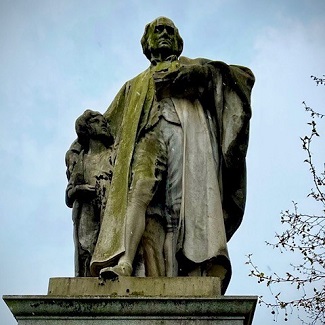Monuments in Princes Street Gardens
Jump to
East Princes Street Gardens
Adam Black statue
This bronze statue on a sandstone plinth depicts Adam Black (1784-1874) in his robes as Lord Provost of Edinburgh. He was a liberal politician and reformer, at a time when parliamentary reform and suffrage was at the top of the political agenda. Blacks, his publishing house, acquired the copyright for the Encyclopaedia Britannica, and in 1851 bought the copyright for Sir Walter Scott's Waverley novels. The statue was designed by John Hutchison RSA (1833-1910).
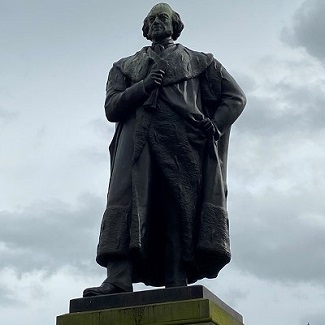
Image courtesy of Capital Collections
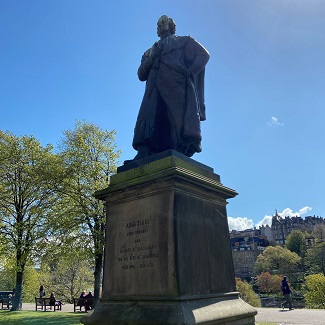
The Holocaust Memorial
This stone was erected by the City of Edinburgh District Council and Lothian Regional Council in connection with the Edinburgh Hebrew Congregation on 14 May 1996. It commemorates the 50th Anniversary of the Liberation of the Belsen Concentration Camp by the British Army and honours the memory of the six million Jews and other innocent victims killed by the Nazi atrocities in World War II.
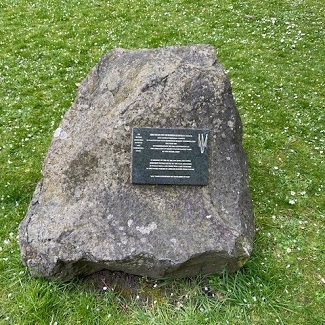
David Livingstone statue
David Livingstone was born in 1813 in Blantyre, Lanarkshire. In 1840, he was ordained as a missionary and sent to South Africa, where he discovered the Victoria Falls. He died in 1873 while searching for the source of the Nile, and is buried in Westminster Abbey. The statue shows him holding a Bible, wearing a cloak and haversack, with a pistol and compass at his waist. The cast off lion skin represents him having survived a mauling. Sculpted by Amelia Paton Hill, (1820 - 1904) one of the few women sculptors in 19th century Edinburgh.
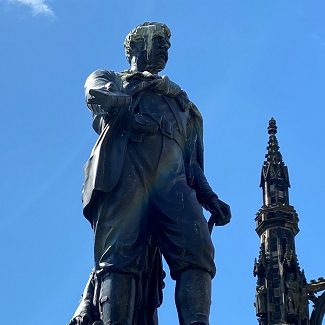
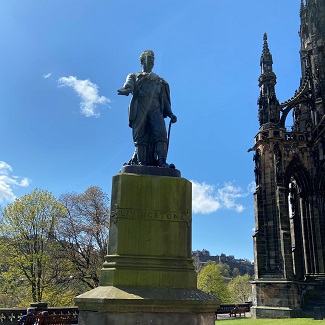
Memorial to the Spanish Brigade
Below the Playfair Steps is a simple poignant rough hewn stone, erected by the International Brigade Association with the help of the Trades Council in 1988. It is inscribed, "To honour the memory of those who went from the Lothians and Fife to serve in the war in Spain 1936-1939. Not a fanfare of trumpets nor even the skirl o' the pipes not for the off'r of a shilling nor to see their names up in light. Their call was a cry of anguish from the hearts of the people of Spain. Some paid with their lives it is true their sacrifice was not in vain."
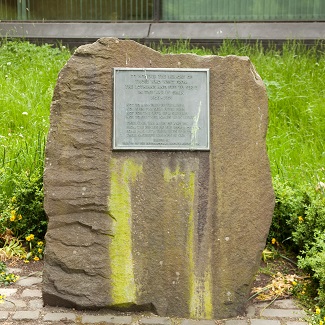
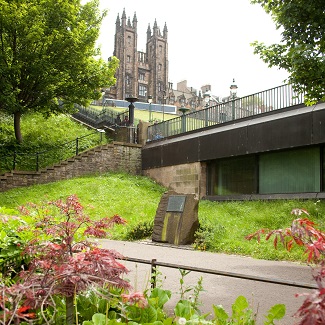
Professor John Wilson statue
Professor Wilson (1785-1854) was born to a wealthy family near Paisley, and studied at Glasgow and Oxford. He was an influential thinker who wrote for Blackwood's Magazine, and became Professor of Moral Philosophy at Edinburgh University, which caused some controversy. He wrote under the pseudonym of Christopher North, and his anti-reform views provoked opposition. The statue which shows him in a thoughtful pose with a half-open manuscript is by Sir John Steell. It was unveiled on the 25th March 1865 - the same day as the nearby Allan Ramsay marble statue.
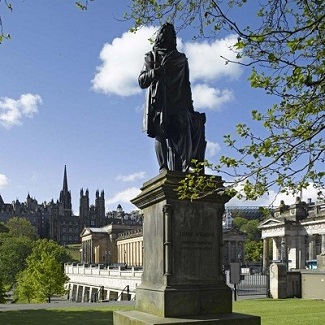
Image courtesy of Capital Collections
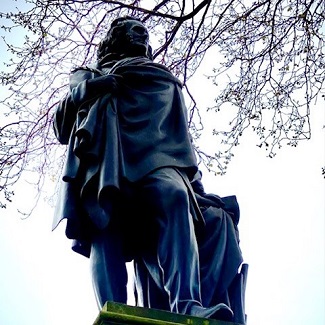
Scott Monument
This is the biggest monument to any writer in the world and commemorates Sir Walter Scott (15th August 1771 to 21st September 1832) who was a hugely successful and influential novelist who created Scottish Romanticism. It is over 200 feet or 61 metres high, built from Binny sandstone in the Gothic architectural style, it has 287 spiral steps to the top, and within niches are 64 character statues from Scott's novels by many well-known sculptors. George Meikle Kemp (25th May 1795 to 6th March 1844), a carpenter from Midlothian, designed the monument inspired by Melrose Abbey. Sir John Steell (1804-91) was the sculptor of the Italian Carrara marble statue of Scott with his deerhound, Maida.
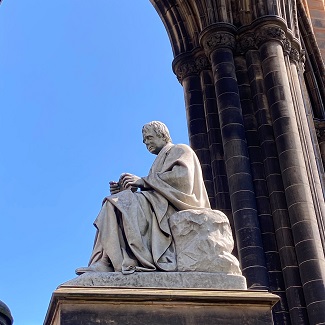
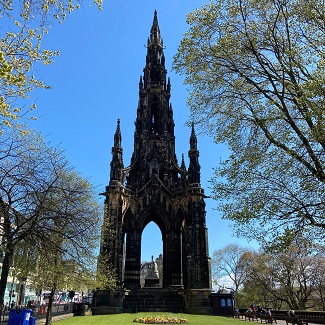
West Princes Street Gardens
Allan Ramsay Statue
Allan Ramsay (1685 -1758) opened Britain's first circulating library on the Royal Mile, wrote ‘The Gentle Shepherd' and was involved in the revival of Scots vernacular poetry. The ten-foot high Carrara marble statue by Sir John Steell shows him wearing a night-cap rather than a wig, an allusion to the fact he had been a wig-maker as a young man. The ornate Binny sandstone plinth is by David Bryce R.S.A.
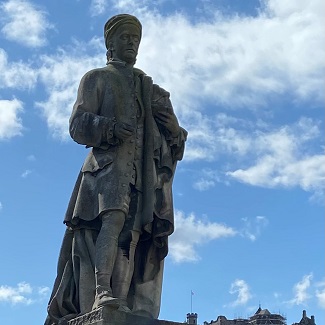
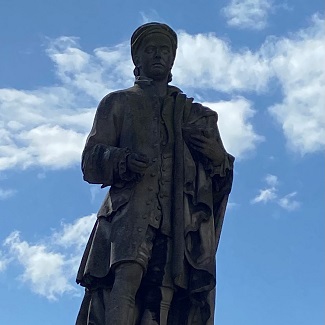
Floral Clock
This circular clock has been planted out since 1903 with up to 40,000 plants in an ornate design reflecting a different theme each summer. The idea came from James McHattie, City Superintendent of Parks and James Ritchie, the Edinburgh clockmaker, using the mechanism of a redundant turret clock. In 1905 a cuckoo which pops out every hour was added, and in 1934 a new mechanism was installed by Ritchie and Sons, who still service it. In the clock's centenary year (2003), it won a Gold medal at the Chelsea Flower Show.
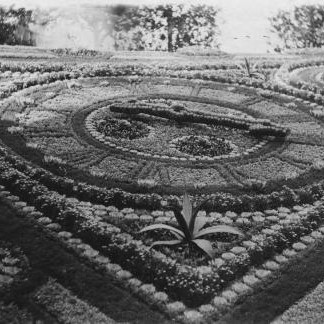
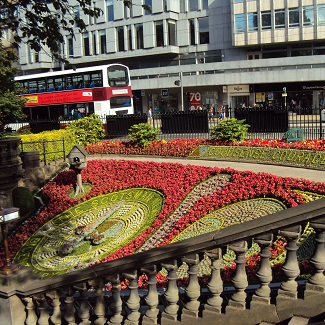
Genius of Architecture Statue
Statue by William Brodie (1815-81), entitled 'The Genius of Architecture Rewarding at Once the Science and the Practice of Art
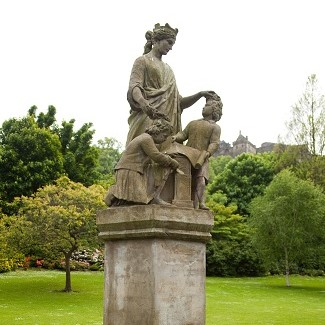
Images courtesy of Capital Collections
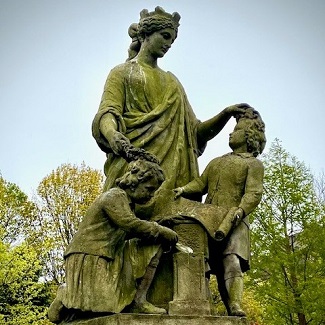
James Young Simpson Statue
James Young Simpson was born in Bathgate, West Lothian of humble origins and rose to become Professor of Midwifery at Edinburgh University in 1840, where he pioneered the use of chloroform as an anaesthetic. Built in 1877 by public subscription and the Simpson Memorial committee, this seated bronze figure in academic robes on a stone plinth was designed by William Brodie RSA (1815-1881) and cast by Masefield and Co., Bronze-founders, London. The plinth is inscribed, 'Sir James Young Simpson, Baronet, MD, DCL, Born 1811. Died 1870. Pioneer of Anaesthesia'.
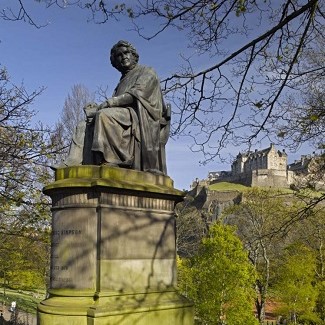
Image courtesy of Capital Collections
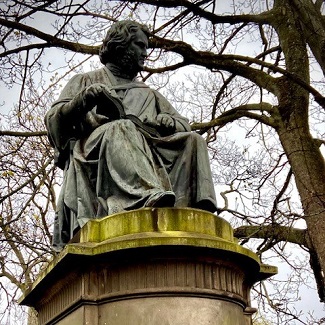
Norwegian Memorial stone
This massive gneiss boulder was presented on the 18th September 1978, by the Norwegian Army and accepted by General Sir Roland Gibbs, who asked Lord Provost Borthwick to receive the stone into the care of the city. It bears the inscription: "During the war years 1940-45 the Norwegian brigade and other army units were raised and trained in Scotland where we found hospitality, friendship and hope during dark years of exile. In grateful memory of our friends and allies on these isles. This stone was erected in the year 1978." On the back, it reads: "This boulder was brought here frmo Norway where it was worn and shaped for thousands of years by force of nature- frost, running water, rock, sand and ice- until it obtained its present shape."
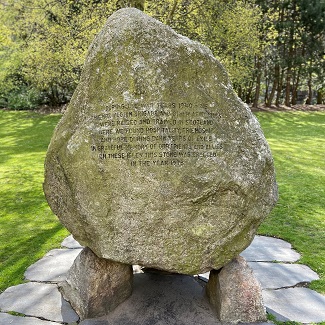
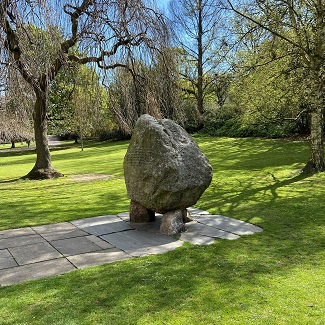
Ross Fountain
This fountain is a magnificent example of 19th century French cast-iron work, from the foundry of Antoine Durenne, with figures sculpted by Jean-Baptiste Jules Klagmann whose work includes fountains in Paris. The central column has mermaid figures sitting on scallop-shell basins with lion’s heads, four figures depict Science, Arts, Poetry, and Industry, surmounted by a female holding a cornucopia. Mr Daniel Ross, a local gun-maker ‘with inclinations to art and natural science’ ordered the fountain at the Great Exhibition of 1862 in London and gifted it to the city; a smaller version is in Brazil. It was erected and operational in 1872 but Ross died before seeing it working.
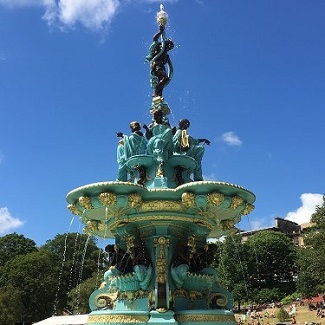
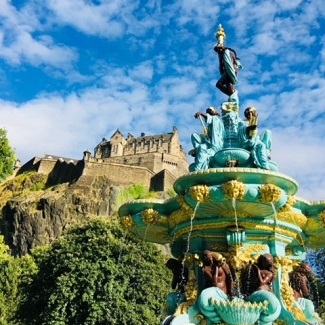
Royal Scots War Memorial
This landscaped monument consists of stone monoliths with depictions of regimental uniforms through the ages. The main stone is incised with the battles from Tangier in 1680 to Burma in 1943-47, with a bronze George Medal and St. Andrews Cross. The fence has roundels depicting the monarchs from Charles I to George VI, others have a thistle and the motto "Nemo Me Impune Lacessit" - 'Nobody provokes me with impunity', or ‘Wha daur meddle wi’ me’.
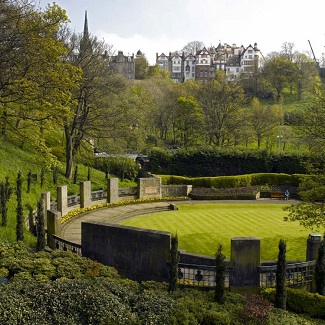
Image courtesy of Capital Collections
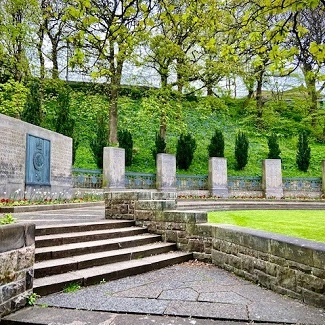
Scottish-American War Memorial
The figure and relief were sculpted between 1924-27 by Robert Tait Mackenzie (1867- 1938), born in Ontario, Canada of Scots parentage and architect Reginald Fairlie (1883-1952) designed the setting.The plinth is inscribed: "The Call 1914. A Tribute From Men and Women of Scottish Blood and Sympathies In the United States of America to Scotland. A People that jeoparded their lives unto the Death in the High Places of the Field" -Judges V.18The bronze bas-relief depicts 'The call to arms', with a cross-section of Scottish working men - miners, shepherds, gamekeepers, farmers and fishermen - being led off to war by a regimental pipe and drum band. The bronze was cast at the Roman Bronze works in Brooklyn, New York. The inscription in the stone is: “If it be life that waits, I shall live forever unconquered, if death, I shall die, at last, strong in my pride and free."- from 'A Creed' a poem by written at Vimy Ridge in 1916 by Lieutenant E. Alan Mackintosh M.C. (1893-1917) of the 5th Seaforth Highlanders, 51st Highland Division.
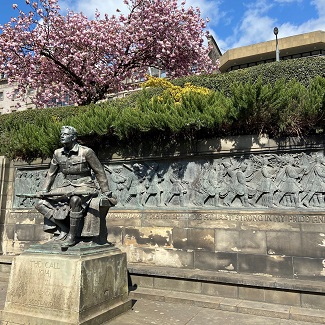
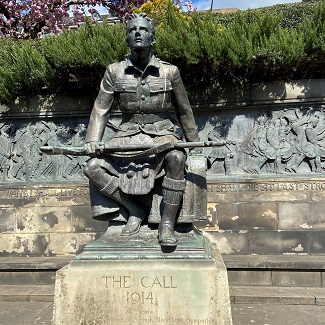
St. Margarets Well
This historic spring well-head takes its name from Queen Margaret, wife of Malcolm Canmore. It provided water to Edinburgh Castle and was attached to the defensive gateway of the Castle Well-House Tower. It reads, “The fountain of ancient wellhouse tower celebrated in the history of the castle since the time of St Margaret, Queen of Scotland in the eleventh century. Restored by the officers of the 93rd Sutherland Highlanders AD 1873."
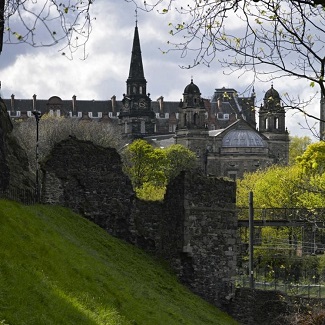
Image courtesy of Capital Collections
The Royal Scots Greys Monument
This equestrian bronze depicts a Royal Scots Dragoon Guard (Carabinier and Greys) in uniform with bearskin hat, sword and rifle, it is by William Birnie Rhind (1853 - 1933) and was unveiled by the Earl of Rosebery on the 16th November 1906. The eagle insignia on the plaque was adopted by the regiment, after Ensign Ewart captured it from the French at the battle of Waterloo in 1815. Plaques to commemorate the regimental fallen in two World Wars, 1914 -18 and 1939 - 45 were added later.
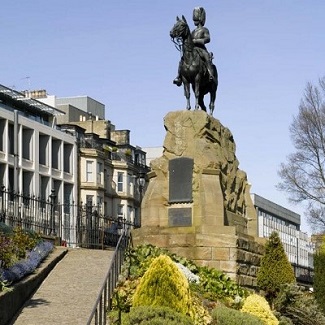
Image courtesy of Capital Collections
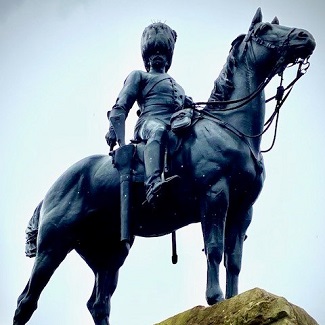
Forget-Me-Not Elephant
This bronze baby elephant covered in forget-me-not flowers was created by sculptor Andy Scott and unveiled in 2019. It is a memorial to those babies and their families who were affected by the historic practices at the Mortonhall Crematorium and according to its creator is a nod to the adage "an elephant never forgets"
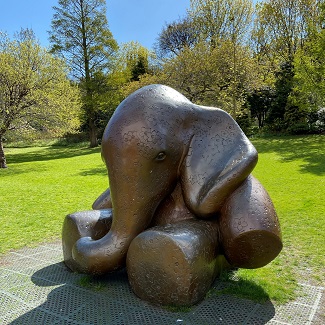
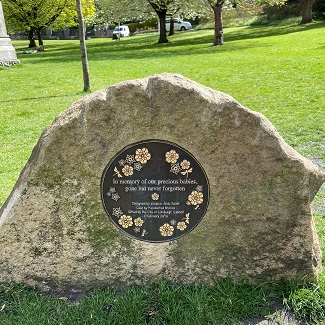
Wojtek The Bear
The statue by sculptor Alan Heriot and funded by the Wojtek Memorial Trust, was unveiled in January 2017 it represents Wojtek and a Polish Army Soldier "walking in peace and unity" and his journey from Egypt to Scotland alongside the Polish Army. Wojtek, also known as Voytek, was rescued as a cub in the Middle East in 1943, the Polish soldiers adopted him and as he grew, he was trained to carry heavy mortar rounds. When their forces were deployed to Europe the only way to take the bear with them was to "enlist" him. So, he was given a name, rank and number and took part in the Italian campaign. At the end of the war the bear - who had also learned how to smoke and drink beer, was billeted at an army camp in the Scottish Borders and when the Polish soldiers were demobilised he was taken to Edinburgh Zoo where he eventually died in 1963.
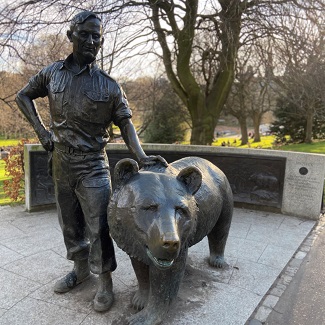
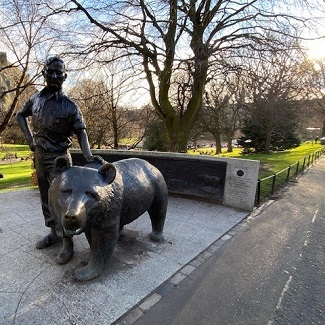
The Thomas Guthrie Statue
D. Thomas Guthrie stands on a Peterhead granite pedestal, with his Bible looking down on a figure of a 'ragged boy'. Sculpted by Frederick W. Pomeroy ARA. (1856-1924). Guthrie was educated at Edinburgh University, and led the breakaway from the Church of Scotland to establish Free St John’s church on Castlehill. He became Moderator of the Free Church assembly in 1862, and published “Plea for Ragged Schools†and “The City, its sins and sorrowsâ€.The inscription reads, "Thomas Guthrie D.D (Doctor of Divinity), preacher and philanthropist 1803-1873, born at Brechin, Forfarshire, an eloquent preacher of the gospel, founder of the original ragged industrial schools, a friend of the poor and the oppressed."
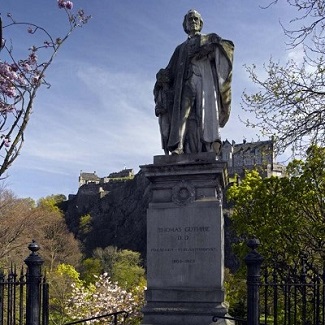
Image courtesy of Capital Collections
